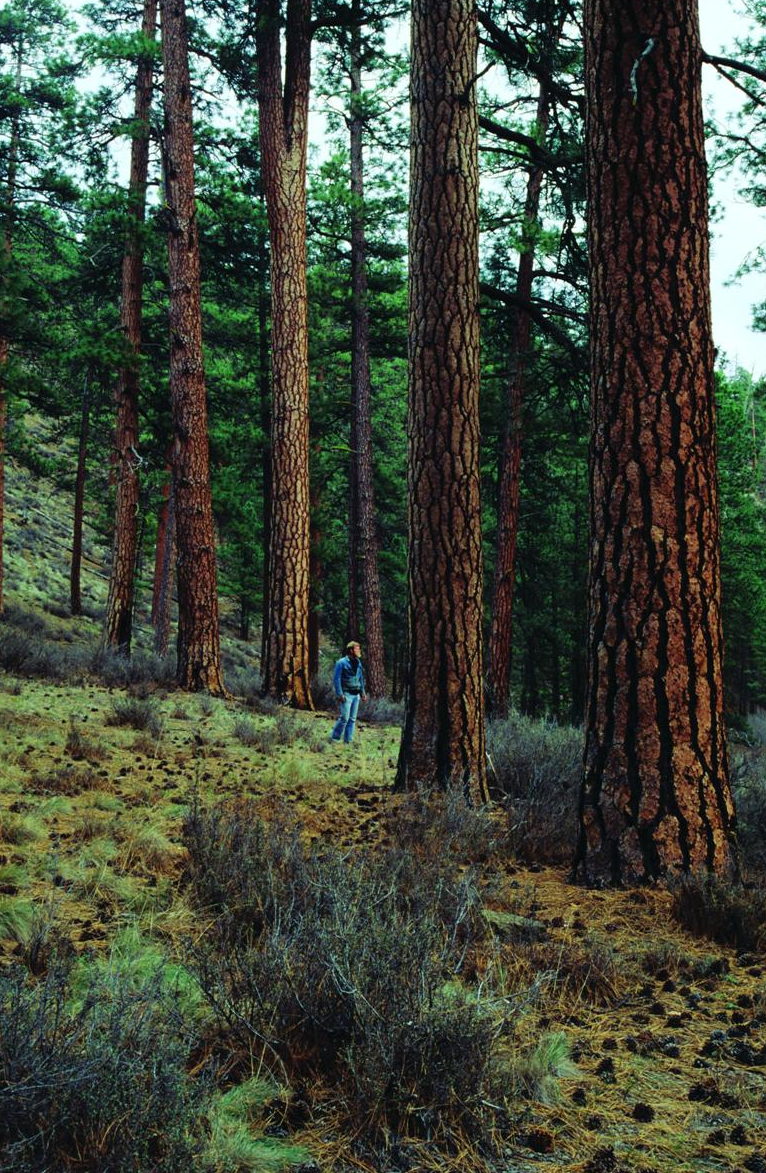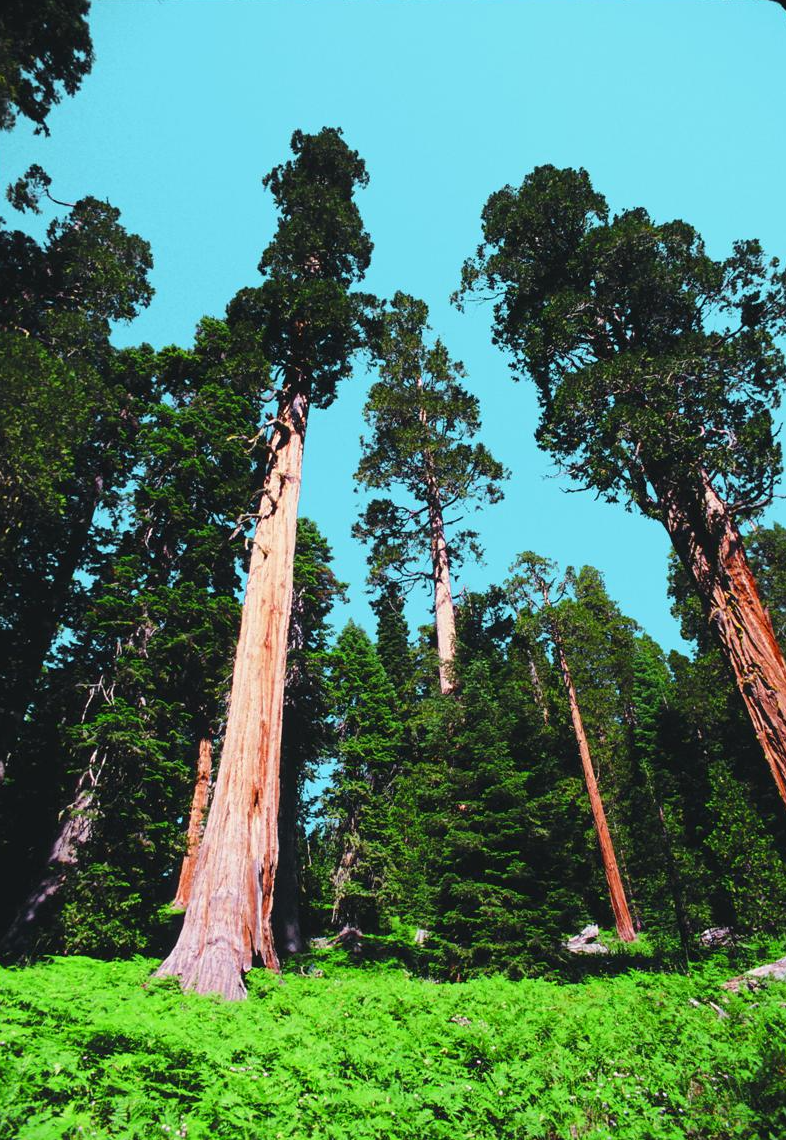This is the second of two Public Lands Blog posts on the president’s executive order (EO) on forests, which, among other things, unambiguously directs the federal forest agencies to conserve the remaining mature and old-growth forests. Part 1 dissected the order. Part 2 places it in the current political context and makes recommendations to various key interests on how best to ensure that the potential of the EO is fulfilled.
Figure 1. Old-growth Douglas-fir and young-growth human. Source: Gary Braasch. First appeared in Oregon Wild: Endangered Forest Wilderness (Timber Press, 2004).
The Political Context for the Executive Order
Biden’s forest EO must be read and understood in the context of a few major political considerations. Following are some observations on this context.
The international context. Because the nations of the world didn’t make enough commitments to keep global warming to below 1.5°C during 26th Conference of the Parties in Glasgow last November, they will meet again in Cairo this November. The Biden administration needs and wants to go into COP27 with additional commitments. The Russian invasion of Ukraine has made it all the more difficult for the United States to pledge to dial back its fossil fuel emissions. However, the administration can easily pledge to protect our remaining mature and old-growth forests and trees, thereby significantly reducing the nation’s atmospheric carbon emissions due to logging. It is not only politically popular at home but also places the US in a better political position to pressure other nations (including, but not limited to, Brazil) to end deforestation and protect their forests.
Figure 2. A mature, going-on-old-growth forest on the Willamette National Forest, Oregon. Source: Kurt Jensen. First appeared in Oregon Wild: Endangered Forest Wilderness (Timber Press, 2004).
Keep it in the forest. While campaigning, candidate Biden pledged to “keep it in the ground,” shorthand for ending the sale of fossil fuels from federal public lands. Between Ukraine, high (but not actually as high as they’ve ever been) gasoline prices, a Trump-appointed judge in Louisiana blocking an administrative ban on new leasing, and the absolute spinelessness of staff, President Biden has—at least for now—effectively reneged on his “end new fossil fuel leasing” pledge. However, he can keep ecosystem-based carbon on federal public lands where it is now—safely locked up in vegetation. It is vital to keep more carbon out of the atmosphere by keeping it in the biosphere and lithosphere.
Mature and old-growth forest. Wisely, the president’s EO calls for the conservation of not only old-growth forest but also mature forest stands. We’re short on old growth now, and the quickest way to get more is to let the mature forest grow into old growth. As a forest reestablishes after a stand-replacing event, when the canopy closes it is a “young” forest. When the forest has reached its peak of annual growth of biomass, carbon, or wood, the forest begins its mature phase. Self-limbing due to canopy closure, individual tree deaths, and other factors cause the stand to mature. Eventually, a mature forest stand becomes an old-growth forest stand.
Pyrophobia. Lordy, are most Americans absolutely irrational about forest fires. Elected officials are more often reflectors than leaders, and this EO reflects Americans’ irrationality about fire. Fortunately, old-growth trees are the most resistant to fire.
Figure 3. Old-growth Douglas-fir in the North Fork Smith River watershed (Umpqua Basin), Oregon. Source: David Stone, Wildland Photography. First appeared in Oregon Wild: Endangered Forest Wilderness (Timber Press, 2004).
Existential threat to Big Timber: only in my dreams. If all federal logging on Forest Service and Bureau of Land Management lands were to come to an end, it wouldn’t significantly affect the nation’s wood consumption. The current total wood production from federal public lands is 646 million cubic feet, or just 4.4 percent of total US consumption. In 2017, 672 million cubic feet of unprocessed wood (logs and chips) was exported from the United States. Each year, 1,152 million cubic feet of wood from urban forests is now landfilled and not made into useful wood products. A regulation protecting mature and old-growth forests will still leave plenty of federal trees available for logging.
Figure 4. This Douglas-fir is perhaps a thousand years old. The only way to know for sure is to cut it down and count the rings. Counts on nearby stumps showed more than six hundred rings on trees that were 3 feet in diameter at their base. If the human is ~5.5 feet high, then the tree is ~11 feet in diameter. In the name of forest “health,” the Forest Service is contemplating cutting down this tree to make more room for a younger (but still rather old for a) ponderosa pine nearby. Source: Umpqua Watersheds. First appeared in Oregon Wild: Endangered Forest Wilderness (Timber Press, 2004).
Existential threat to the Forest Service and the BLM—as they have defined themselves. Ending the logging of mature and old-growth forests and trees would force the federal forest agencies to reinvent themselves and become relevant to the twenty-first century. (They seem stuck at the beginning of the last decade of the twentieth.)
Figure 5. Old-growth Douglas-fir and other species sequester (remove from the air) and store vast amounts of carbon. Source: Gary Braasch. First appeared in Oregon Wild: Endangered Forest Wilderness (Timber Press, 2004).
Figure 6. A mature, not old-growth (trees not as large, bark not as furrowed) stand of Douglas-fir in southwest Oregon. Source: Ken Crocker. First appeared in Oregon Wild: Endangered Forest Wilderness (Timber Press, 2004).
My Recommendations
Here are my major recommendations to the various players (including you) in this opportunity to conserve and restore mature and old-growth forest and trees.
Figure 7. An old-growth ponderosa pine in a stand of ponderosa pine that the BLM won’t likely consider a stand that the Biden executive order directs it to protect. The big yellowbelly is within a few feet of the Pacific Crest National Scenic Trail in Jackson County, Oregon, but national trail status is conferred only on the trail, not any of the trail’s habitat. Source: Elizabeth Feryl, Environmental Images. First appeared in Oregon Wild: Endangered Forest Wilderness (Timber Press, 2004).
To the Federal Forest Agencies
1. Admit you are the problem. You also need to admit that the single greatest threat to mature and old-growth forests is the duo of the Forest Service and the Bureau of Land Management. For more than a century (and almost as long for the BLM), the Forest Service has offered up logging as the way to execute a federal forest policy, including addressing forest crises caused by earlier logging by the agency.
2. The only adequate course of protection is a permanent administrative rule codified in the Code of Federal Regulations.Merely revising land and/or resource management plans will not do. Issuing a slick PR document saying that the agencies are now protecting mature and old-growth forests while not changing any existing behaviors will not do. Renaming timber sales to pose as mature- and old-growth-forest restoration projects will not do.
Figure 8. Old-growth ponderosa pine in the Metolius watershed, Oregon. Source: Elizabeth Feryl, Environmental Images. First appeared in Oregon Wild: Endangered Forest Wilderness (Timber Press, 2004).
3. While an inventory of mature and old-growth forests and trees is a good idea that is long overdue, you need not wait until you’ve done your inventory to start the protection effort. The final administrative rule must be in place before the 2024 election. The agencies don’t know exactly where the older forests and trees are. (Reports an article in the New York Times on January 9, 2001: “The exact extent of old-growth timber has never been mapped, despite directives to do so under the last Forest Service policy statement, issued in 1989.”) But they don’t need to know to do a rule. We already know what needs to be protected and how much mature and old-growth forest is left.
4. The rule should protect all mature and old-growth trees, be they living or dead, standing or fallen. There is more life in a dead tree than a live one. When a tree dies, whether by fire or wind or insect or volcano, most of the tree’s carbon remains on site and out of the atmosphere. When a tree is logged and sent to the mill, most of the carbon soon ends up in the atmosphere.
Figure 9. Whitebark pine on the Fremont National Forest, Oregon. The Biden executive order calls for the protection of all mature and old-growth stands. Will the Forest Service classify this congregation of whitebarks as a stand? Source: George Wuerthner. First appeared in Oregon Wild: Endangered Forest Wilderness (Timber Press, 2004).
5. The rule should also protect relic mature and old-growth trees that are not within mature and old-growth stands. Leave no old tree behind.
6. The rule should result in there being much more mature and old-growth forest in the future than there is now. A large component of the excessive carbon in the atmosphere now is due to previous logging and forest conversion. The absolute best and cheapest carbon-capture-and-storage technology ever invented is a forest allowed to continue or allowed to be old.
7. The rule should respect the ticking clock. Joe Biden’s first, if not only, term ends at high noon on Monday, January 20, 2025. So as not to be vulnerable to a simple (pronounced “simplistic”) potential congressional override, this protective final rule must be published in the Code of Federal Regulations by no later than the end of March 2024.
Figure 10. Those old-growth ponderosas on the Fremont National Forest may not be protected under the Biden executive order, because they are not in a “stand” of trees. Source: Sandy Lonsdale. First appeared in Oregon Wild: Endangered Forest Wilderness (Timber Press, 2004).
To the White House
1. You will have to force the Forest Service and the Bureau of Land Management to do what is best for the climate, for nature, and for President Biden’s legacy. The agencies really don’t want to protect mature and old-growth forests. It goes against the very nature of bureaucrats, who loathe to have their discretion limited. The agencies will continue to lie, spin, and prevaricate in hopes that your administration will fail to conserve and restore America’s mature and old-growth forests for the benefit of this and future generations.
2. 30x30. Only if the final protections are strong and enduring enough—and the protected forestlands are also withdrawn from the application of the mining laws—will the new protections qualify as conserving 30 percent of the nation’s lands and waters by 2030.
Figure 11. Old-growth incense cedar on the Umpqua National Forest, Oregon. Source: Sandy Lonsdale. First appeared in Oregon Wild: Endangered Forest Wilderness (Timber Press, 2004).
To the Conservation Community
1. Recognize that amidst a huge amount of hedging, pandering, misdirecting, and/or ass covering in the executive order lies an opportunity to fundamentally change the course of federal forest management in the United States by permanently conserving the last of the nation’s mature and old-growth forests and trees, and to restore much that has been lost. Don’t be paralyzed by what in your mind is a less-than-perfect executive order. Don’t fall for the misdirection.
Figure 12. Young Sitka spruce growing out of a very old and long-dead Sitka spruce on the Siuslaw National Forest, Oregon. Source: Elizabeth Feryl, Environmental Images. First appeared in Oregon Wild: Endangered Forest Wilderness (Timber Press, 2004).
2. Get involved by signing up for updates from the Climate Forests Campaign. At nearly a hundred organizations and growing, the campaign has most major national conservation organizations (aside from The Wilderness Society) on board, as well as an increasing number of regional and local organizations (which deserve your financial support—earmarked for mature and old-growth forest conservation).
Figure 13. Bald eagles enjoying a stand of mature lodgepole pine on the Deschutes National Forest, Oregon. Source: Sandy Lonsdale. First appeared in Oregon Wild: Endangered Forest Wilderness (Timber Press, 2004).
Seize the Day!
We are about to embark on a great crusade, one we have striven toward for lo these many years. The eyes of the nation—nay the world—are upon us. The hopes and dreams of forest-loving people everywhere march with us. In company with our brave allies and siblings-in-arms on other political fronts, we will save the last of the nation’s mature and old-growth forests—and restore what has been lost.
Our task will not be an easy one. The timber industry, along with the rest of the fire-industrial complex, is well trained, well equipped, and battle hardened. But so are we.
Figure 14. Western larch on the Wallowa-Whitman National Forest. As a deciduous conifer, the larch has a contrary nature. Each autumn, the needles fall off. Source: Sandy Lonsdale. First appeared in Oregon Wild: Endangered Forest Wilderness (Timber Press, 2004).
This is the year 2022! Much has happened since Big Timber’s triumphs in the 1980s. We have inflicted great defeats on Big Timber. Federal logging levels are down from obscene historic highs but have been creeping up. We have overwhelming superiority in public support and scientific justification. It’s time to end the chronic continued logging of mature and old-growth forests. The tide has turned, not only in metropolitan areas but also in micropolitan and even rural areas.
Figure 15. Old-growth ponderosa pine forest in the Lookout Mountain area on the Ochoco National Forest. The long-dead and downed ponderosa pine tree still holds the vast majority of the carbon it stored while standing and alive. Source: Larry N. Olson. First appeared in Oregon Wild: Endangered Forest Wilderness (Timber Press, 2004).
I have full confidence in the ability of the public land conservation and climate protection communities to convince the Biden administration. We need not accept less than full victory!
This is a great and noble undertaking.
Bottom Line: For President Biden to permanently conserve the nation’s remaining mature and old-growth forests, everyone who cares has to show up and not only pull their own weight but also do some heavy lifting.
Figure 16. I have no faith that Forest Service chief Randy Moore will do the right thing and actually conserve the remaining mature and old-growth forests in the National Forest System. His underwear has been Forest Service green for forty-four years and counting. He epitomizes all that is wrong conservationwise with the Forest Service. Source: USDA Forest Service.
Figure 17. I have some faith that Bureau of Land Management director Tracy Stone Manning will do the right thing and actually conserve the remaining mature and old-growth forests on public lands administered by the BLM. She is not a career BLMer, comes from a history of conservation activism, and has served in various conservation and environmental protection policy roles in state and federal government. She is astute enough to realize that this could be her great legacy. Source: USDI Bureau of Land Management.
















